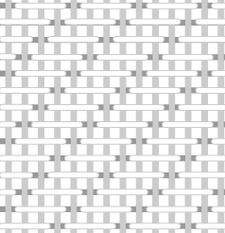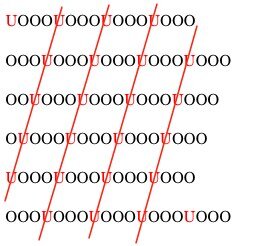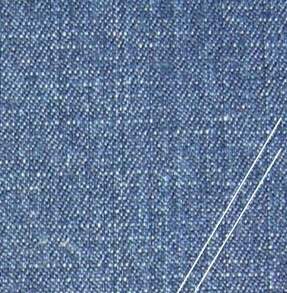Twill Talk
I've had a few questions in my mailbox about linen twill and I'm investigating what kind of twill I want to use for the upcoming screen project so it's a perfect time to talk about linen twill!Twill is a type of weave. The main feature of a twill weave is the pronounced diagonal lines that run along the width of the fabric. It's possible to buy linen twill (the kind used most often for crewelwork), wool twill, cotton twill and horsehair twill, to name but a few. The most common twill is the one you wear - most blue jeans are made of twill fabric! I've marked the diagonal so you can see it better. Twill is a very durable weave - which is why is used for blue jeans!
Twill is a weave where the end result is a fabric with diagonal lines (called twills) rather than vertical lines. The twill weave looks more like this //////// rather than this ||||||| when it's finished. How does the weaver get this kind of texture in the twill fabric? By weaving the weft threads over one or more warp threads but staggering where they cross on each row so twills are produced. Here is a diagram to help you understand.
 If you look at the top row of the weaving diagram, you can see the weft thread (the one that goes from left to right) goes under 1 warp thread, over 3, under 1, over 3 etc.
If you look at the top row of the weaving diagram, you can see the weft thread (the one that goes from left to right) goes under 1 warp thread, over 3, under 1, over 3 etc.
Here is the weaving pattern shown another way using 'U' for under and 'O' for over. Where the weft thread goes under the warp thread, the warp thread lies on top and makes the typical diagonal twill of the fabric.
 Why do we use twill for crewel work? There are both historical and artistic reasons. Traditionally crewelwork was stitched on twill fabric. Due to it's durability it was used during the initial growth of crewelwork for bed hangings and other home furnishings. Twill has the advantage over other fabrics of being quite substantial and can therefore support the density of stitches found in crewelwork. A lightweight linen would pucker badly, ruining the stitching while twill nicely supports the wool threads. As crewelwork became fashionable for other home furnishings, twill continued to be used because it's a fine upholstery fabric. It's one of the most long lasting weaves and wears beautifully.
Why do we use twill for crewel work? There are both historical and artistic reasons. Traditionally crewelwork was stitched on twill fabric. Due to it's durability it was used during the initial growth of crewelwork for bed hangings and other home furnishings. Twill has the advantage over other fabrics of being quite substantial and can therefore support the density of stitches found in crewelwork. A lightweight linen would pucker badly, ruining the stitching while twill nicely supports the wool threads. As crewelwork became fashionable for other home furnishings, twill continued to be used because it's a fine upholstery fabric. It's one of the most long lasting weaves and wears beautifully.
Next time I'll be explain S twist and Z twist - both in the fibers and the weave of the twill and show you some examples of the 3 twills I'm considering using for my screen project. If you have any questions you'd like to see me answer next time, please leave a comment and I will do my very best to find out the answer!Until then, happy stitching!

